16 common plants you should NEVER grow in your garden
Proceed with caution when it comes to these poisonous or invasive plants
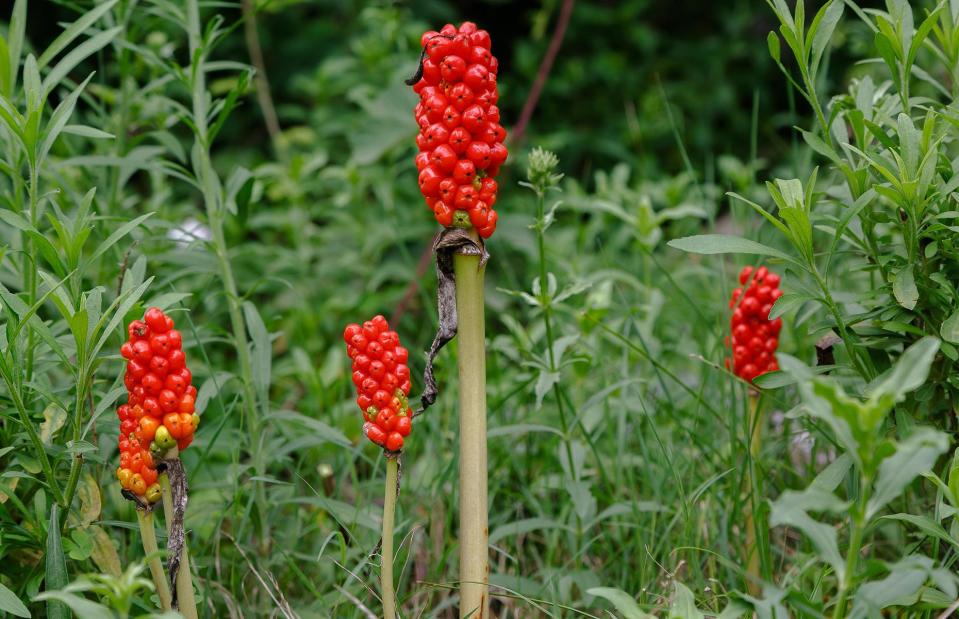
Greens and Blues / Shutterstock
There's nothing better than a garden filled with vibrant and diverse vegetation, but not all plants and flowers are good for our gardens. From invasive weeds that can cause structural damage and cost thousands to irradicate, to pretty blooms that are harbouring poison inside their leaves or roots, these problematic plants could cause you a headache.
Read on to discover more about these invasive or toxic plants and what you should do if you already have them growing in your garden...
Green alkanet (Pentaglottis sempervirens)
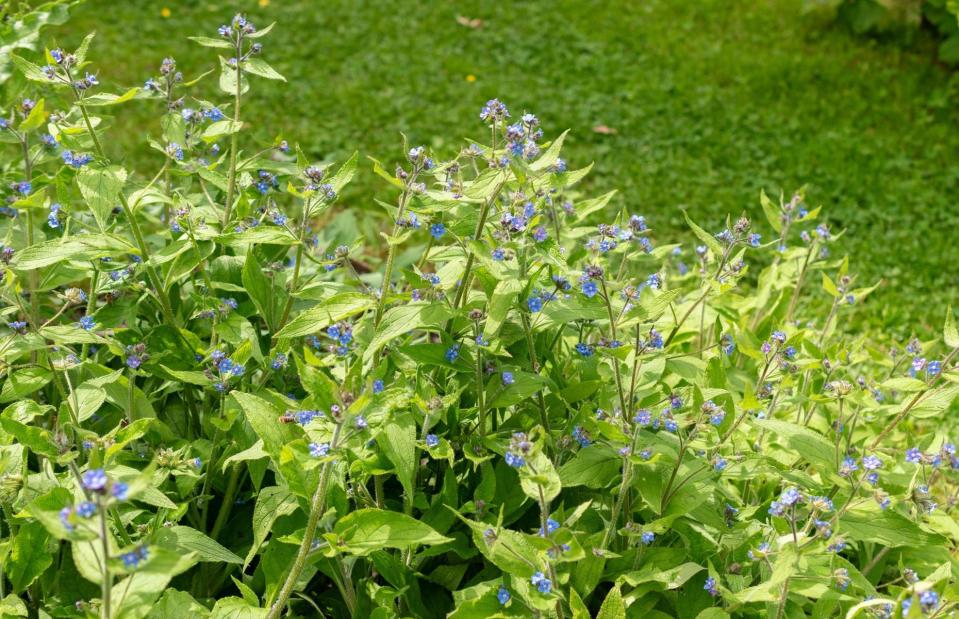
Robert Buchel / Shutterstock
Considered a weed by many, green alkanet is often seen growing in damp, shady places like woodlands and grasslands. The perennial is indigenous to southwest Europe and was introduced to British gardens in the 18th century.
Both pollinators and gardeners love the plant's pretty blue flowers – which are edible – and green alkanet is also defined by its large, bristly, oval leaves. However, the invasive species can soon cause problems for homeowners.
What problems can green alkanet cause?
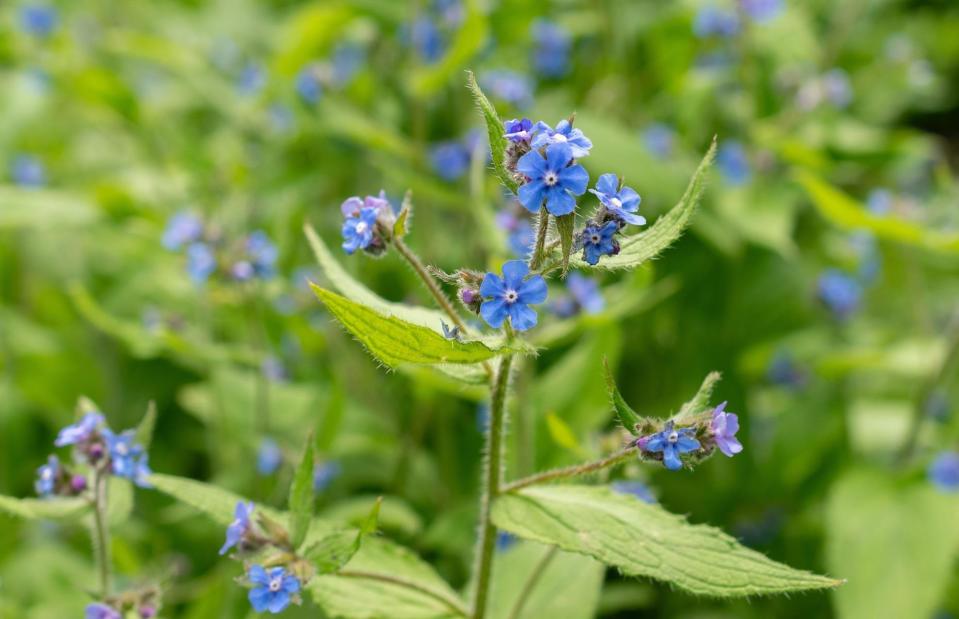
Robert Buchel / Shutterstock
Green alkanet can soon take over your garden. As well as being popular with pollinators that spread the plant to different parts of the garden, it also produces seeds, which can be blown or transported to new locations on clothing or animal fur.
How to stop green alkanet causing harm
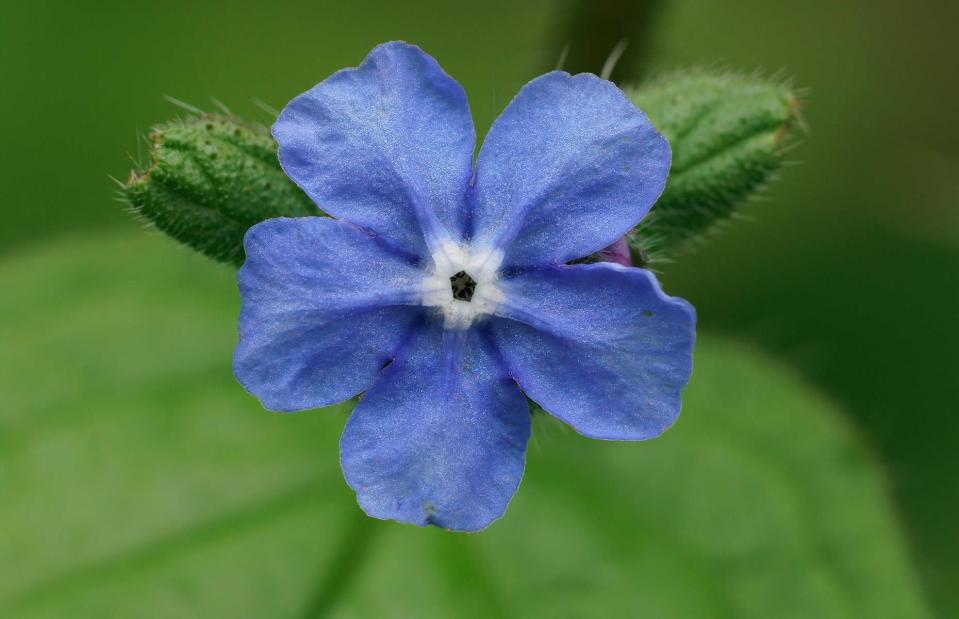
HWall / Shutterstock
Enjoying the plant in your garden is quite easy, but you must control its spread. To do this, deadhead the plant before it sets seed and remove seedlings from unwanted locations. A layer of mulch will also stop any seeds from making their way into the soil.
Dig deeply to reach the roots if you want to remove the plant. Just take care not to add any roots to your compost bin.
Rhododendron (Rhododendron ponticum)
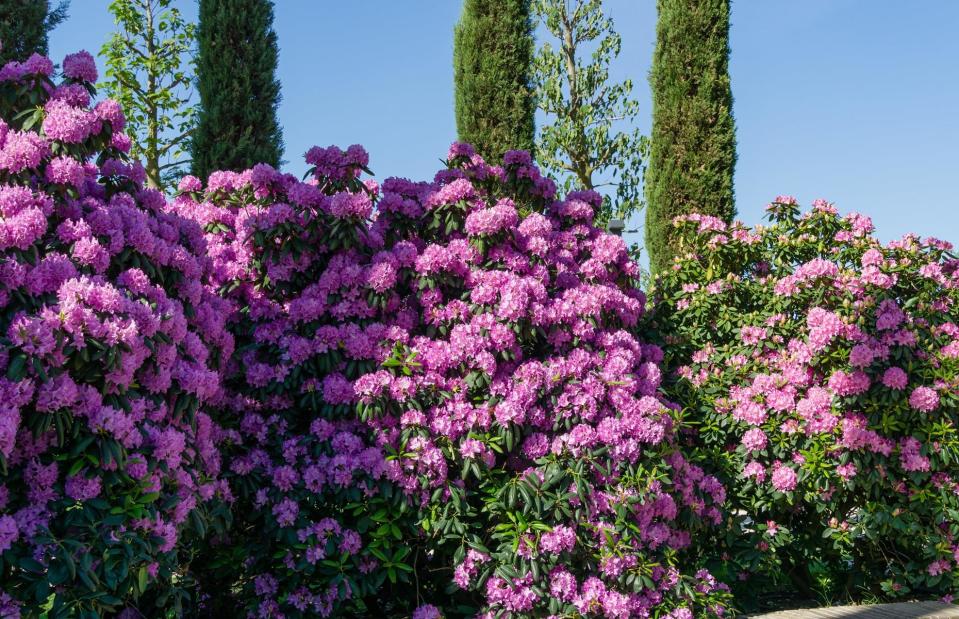
Marinodenisenko / Shutterstock
Often found on large country estates, the rhododendron bush is beautiful and dramatic, offering up spectacular displays of purple, white, pink and even orange flowers. Also known as azaleas, this woodland shrub likes to be planted in dappled shade and enjoys a rich, neutral to acidic soil that's both moist and well-drained.
As much as it is loved, did you know that this bush isn't native to Europe or North America? Rhododendrons are indigenous to parts of the Himalayas, Southeast Asia and New Guinea. And that, we're afraid, is the issue...
What problems can rhododendrons cause?
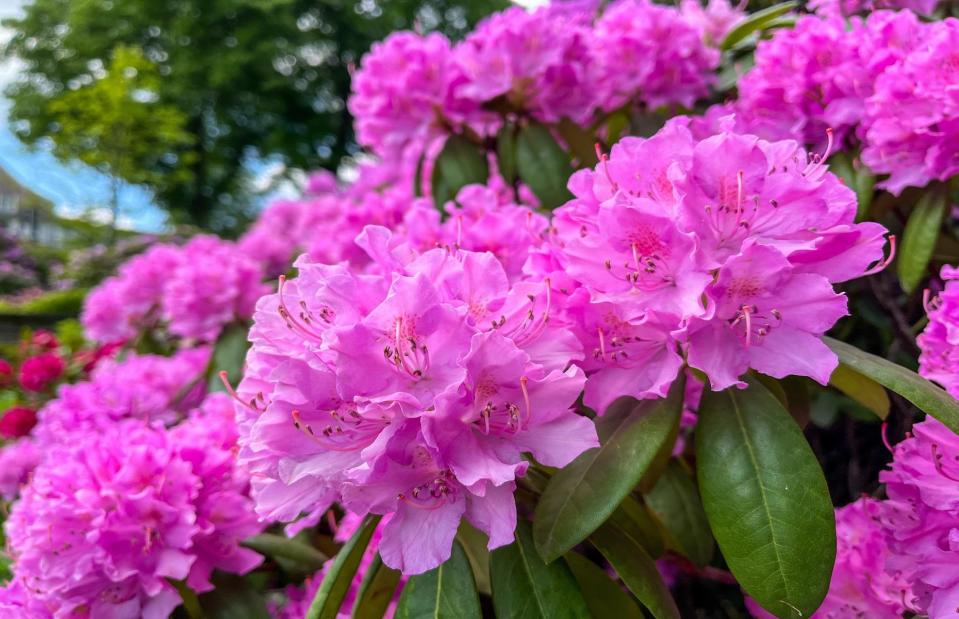
Soeren Schulz / Shutterstock
Sadly, this non-native species is proving detrimental to native plants. Its dense thickets create huge areas of shade, stopping other plants from thriving. In fact, once it has invaded a garden, few other plants can survive.
In 2024, The Woodland Trust revealed that the plant also carries a disease that could be fatal to more than 150 species, while also "choking native woodland and shading out characteristic plants".
How to stop rhododendrons causing harm
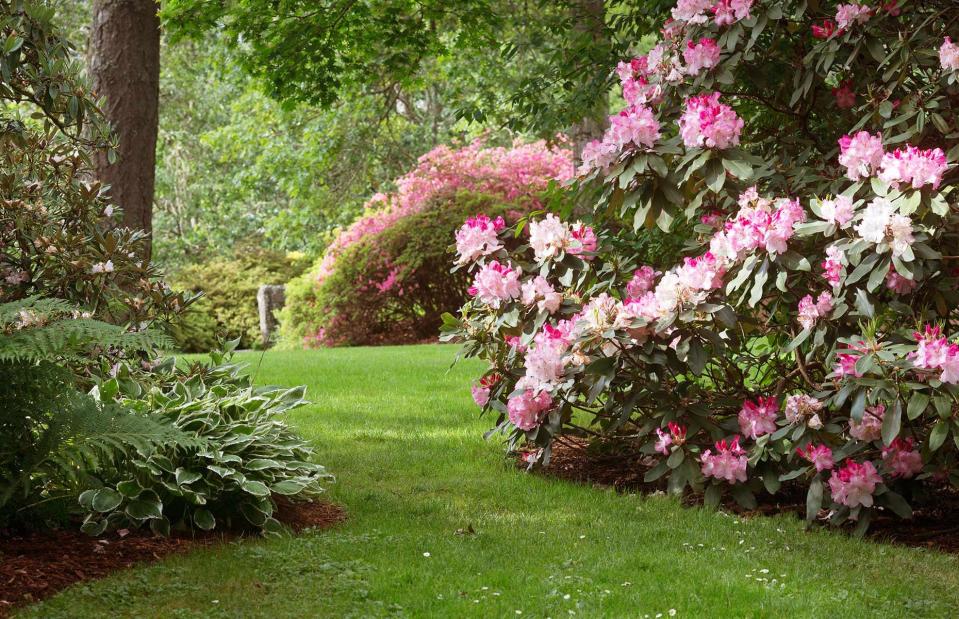
Jamie Hooper / Shutterstock
The shrub is also poisonous to livestock, so should never be planted near open fields where cattle roam.
If you have a bush growing in your garden and want to remove it, then you can do so yourself by either pulling it out of the ground (if it's small) or digging up its roots.
Cuckoo-pint (Arum maculatum)

olko1975 / Shutterstock
Also known as lords-and-ladies, the cuckoo-pint plant is native to most parts of Europe, as well as some countries in northern Africa. As a wildflower, the plant isn't often found in gardens. However, it will thrive in cool, shaded spots, such as under a tree, and can also cope with drought and warm temperatures well. It can often be found in woodlands or dotted along hedgerows, growing up to 1.5 feet (0.5m) tall and spreading across the ground.
It also changes its appearance throughout the seasons. In early spring, it features large, arrow-shaped leaves (green and often marbled) and further into the season, impressive hooded flowers appear, complete with a short, club-shaped spike. Then, in autumn, the plant produces bright orange or red berries.
What problems can cuckoo-pint cause?
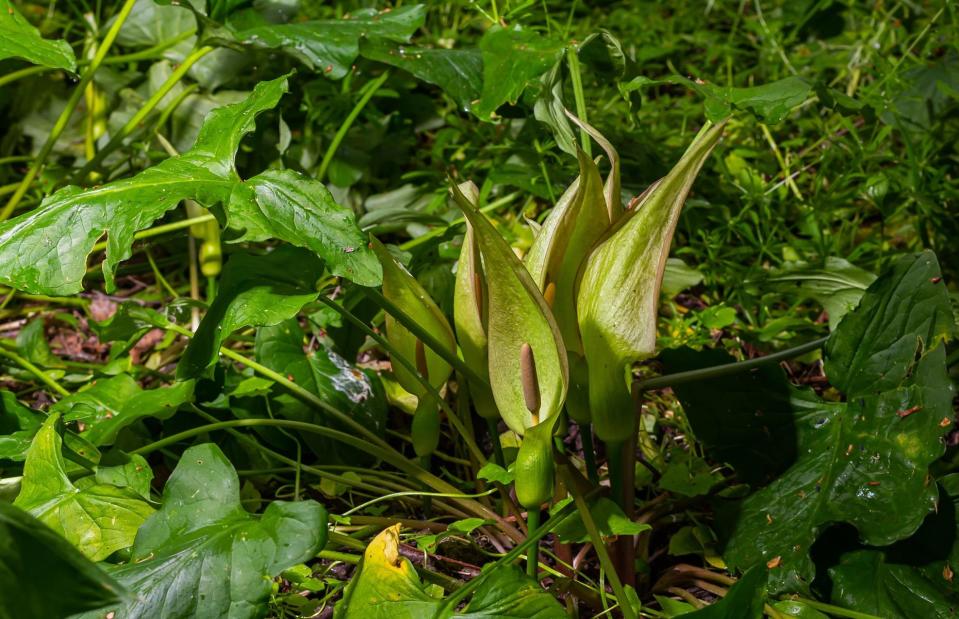
olko1975 / Shutterstock
So, why is this unusual wildflower problematic? Well, the plant self-seeds, which means it spreads quickly and can soon get out of control.
Birds also spread the berries and new plants will begin cropping up. In fact, it can become a nuisance weed if left untamed. If you have the plant growing in your garden, then you need to ensure you keep on top of it.
How to stop cuckoo-pint causing harm
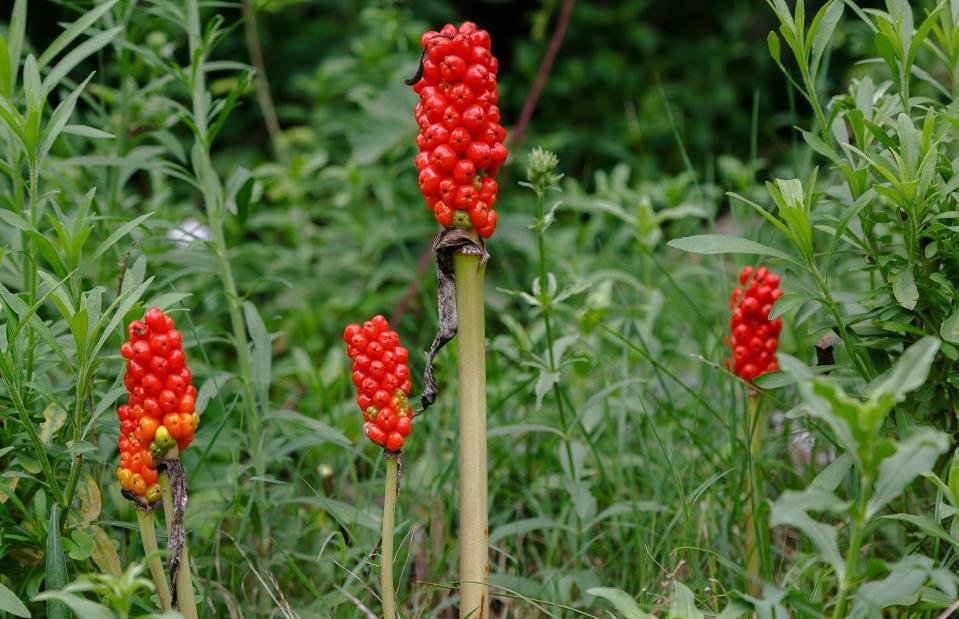
Greens and Blues / Shutterstock
Ensure you remove any berries before they have time to ripen, deadhead the flowers when they begin to die and, if all else fails, dig out parts of the plant.
Another issue to note is that all parts of the cuckoo-pint are poisonous and can cause skin irritation if touched, so always wear gloves. If you have children, it might be best to remove the plant entirely.
Foxgloves (Digitalis purpurea)
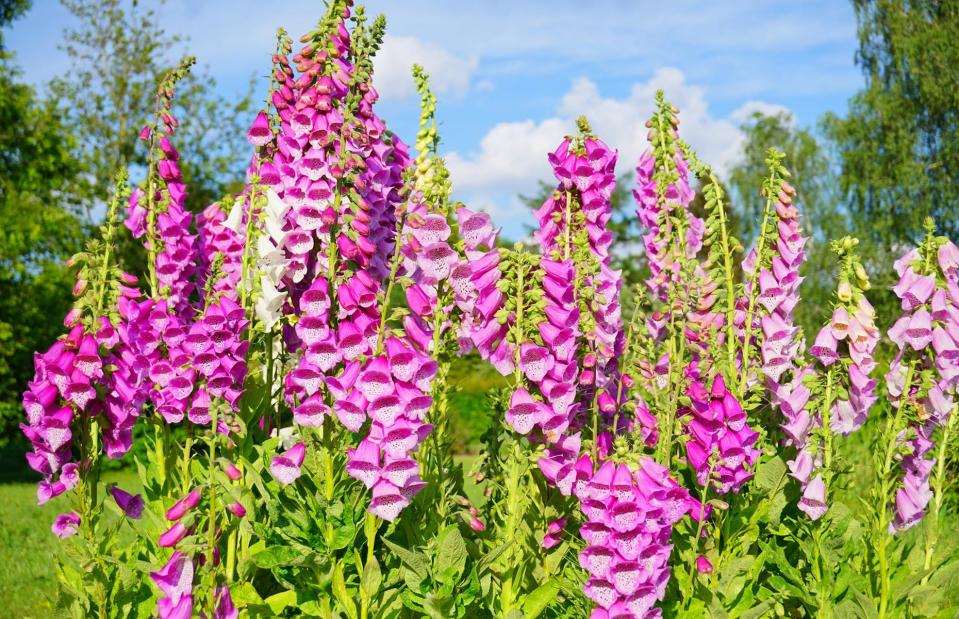
Mariola Anna S / Shutterstock
If you're a fan of classic crime novels, then you've likely heard of Digitalis. Also known as foxgloves, this pretty plant features long stems of pink and purple, tubular shaped flowers. Native to Europe, as well as parts of Asia and Africa, foxgloves love light shade and mineral-rich or acidic soil, so can often be found in woodlands or next to hedgerows.
Thanks to their pollen-rich flowers, they're a great resource for bees and other pollinators, so it isn't hard to see why people would want this vibrant and striking plant in their garden. But here's why you should reconsider...
What problems can foxgloves cause?
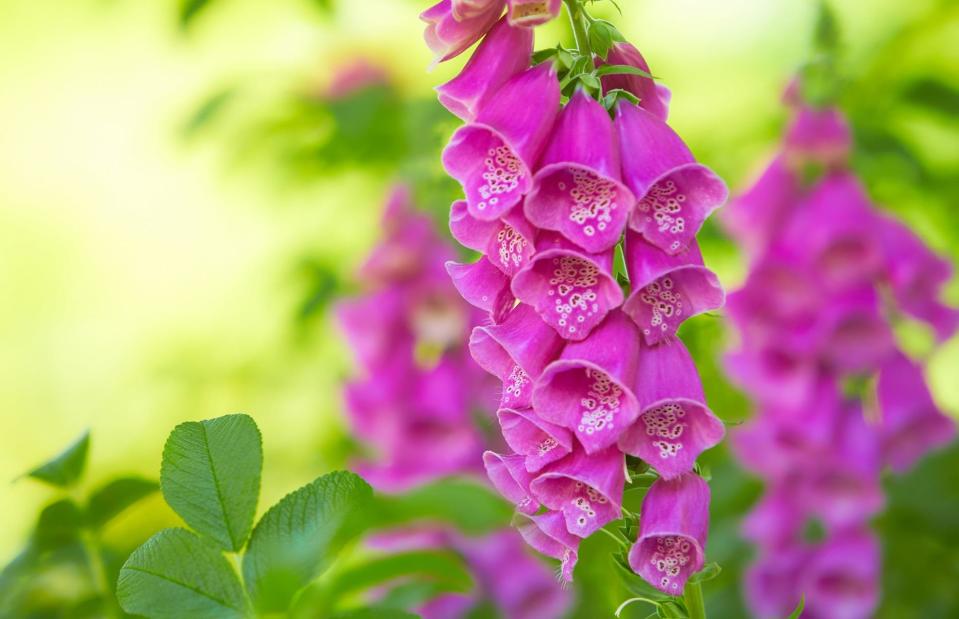
Irene Fox / Shutterstock
Pretty but poisonous, foxgloves contain cardiac glycosides, organic compounds that can have a devastating effect on the heart. In fact, it's poisonous if ingested.
Symptoms include headaches, nausea, skin irritation and diarrhoea. In severe cases, it can lead to problems with the heart, kidneys and even eyesight.
How to stop foxgloves causing harm

Monkey Business Images / Shutterstock
Should you have the plant in your garden, you'll want to ensure it's out of reach of small children. If this isn't possible, then ensure all members of the family are educated about the dangers of the plant, if ingested.
Bamboo (Bambusa vulgaris)
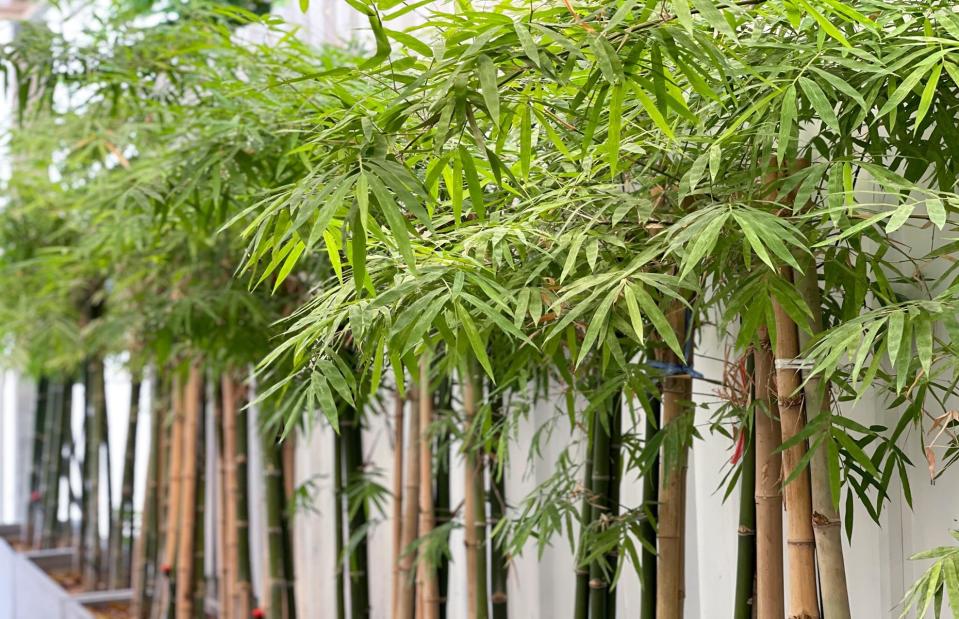
Chomipoo / Shutterstock
With their tall, swaying canes and evergreen foliage, bamboo plants are undeniably beautiful and look fantastic in gardens. However, this hardy and fast-growing plant can soon become out of control.
What problems can bamboo cause?

vitrolphoto / Shutterstock
Native to tropical climates, such as Australia and South America, it has recently become an invasive UK plant, with some homeowners experiencing extensive damage to their properties from this vigorous plant.
That's because its thick canes and roots can make their way through brickwork, drains, cavity walls and even cracks or weaknesses in concrete.
How to stop bamboo causing harm
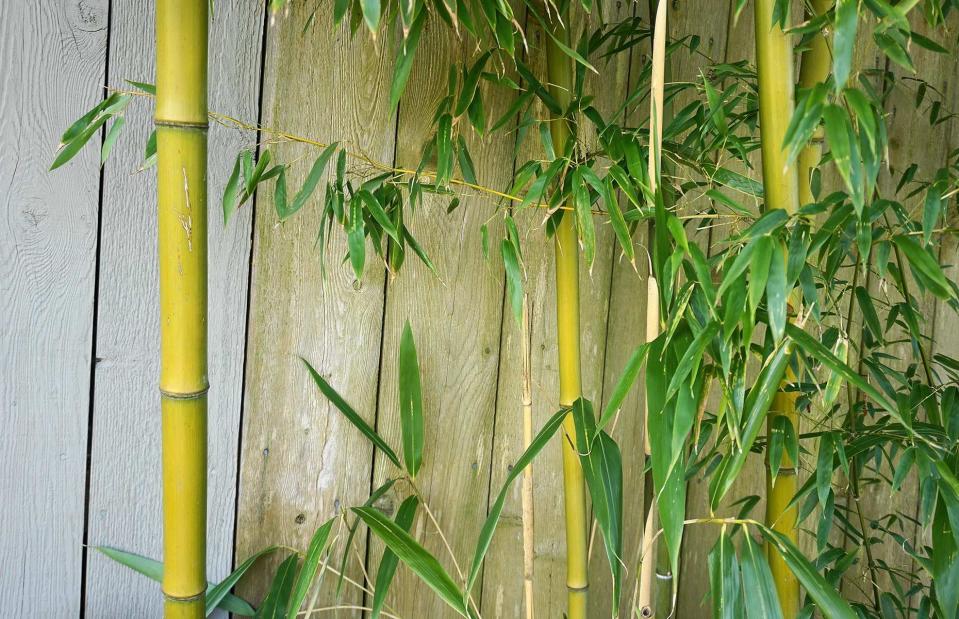
lenic / Shutterstock
There's nothing necessarily wrong with growing bamboo in your garden and if you currently have some that's flourishing without becoming problematic, then leave it be. However, if left unchecked, some bamboo varieties can soon cause problems.
Always plant bamboo in pots to keep roots contained. Avoid running varieties and ensure you prune the plant regularly. You can also remove the plant and restrict its size by digging out clumps, but proceed with caution and, if in doubt, call in the professionals.
Hemlock water-dropwort (Oenanthe crocata)
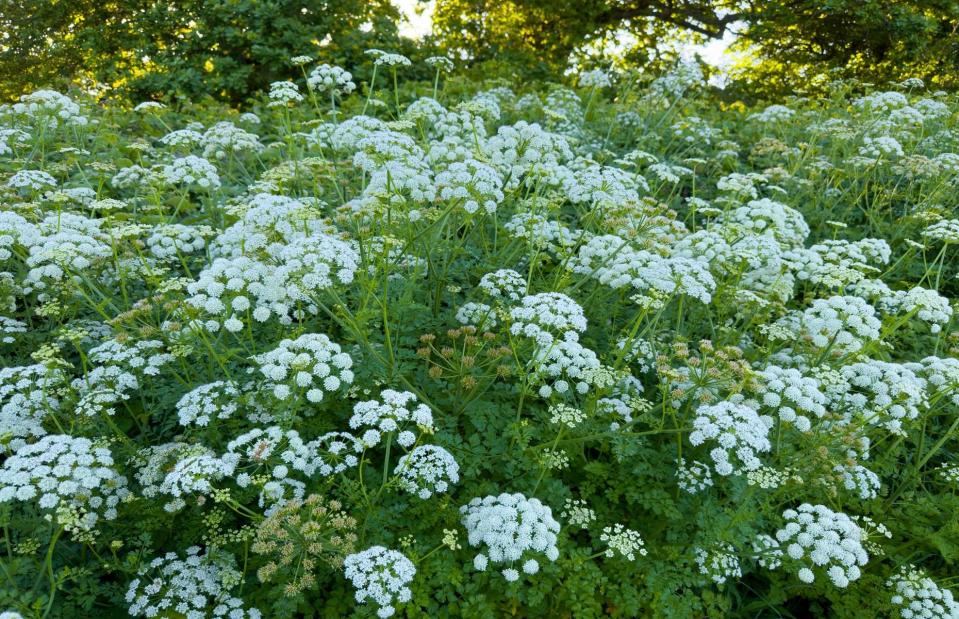
David Dennis / Shutterstock
Hemlock water-dropwort is a perennial plant with bright green, long and grooved stems, topped by delicate, umbrella-shaped white flowers. The plant enjoys full sun and poorly–drained soil, so can often be found in damp meadows and near ponds.
Native to Europe, north Africa and western Asia, it doesn't require a lot of maintenance and is generally disease-free, so beginner gardeners might be tempted to plant it.
What problems can hemlock water-dropwort cause?

Svetlana Zhukova / Shutterstock
However, this delicate plant is actually toxic and contains oenanthetoxin and cicutoxin, which attack the central nervous system. All parts of the plant are poisonous, but especially the roots, which often get mistaken for wild parsnips. Eating Hemlock water-dropwort often has fatal results, for both adults and dogs, so you want to ensure you avoid this plant in your garden.
How to stop hemlock water-dropwort causing harm
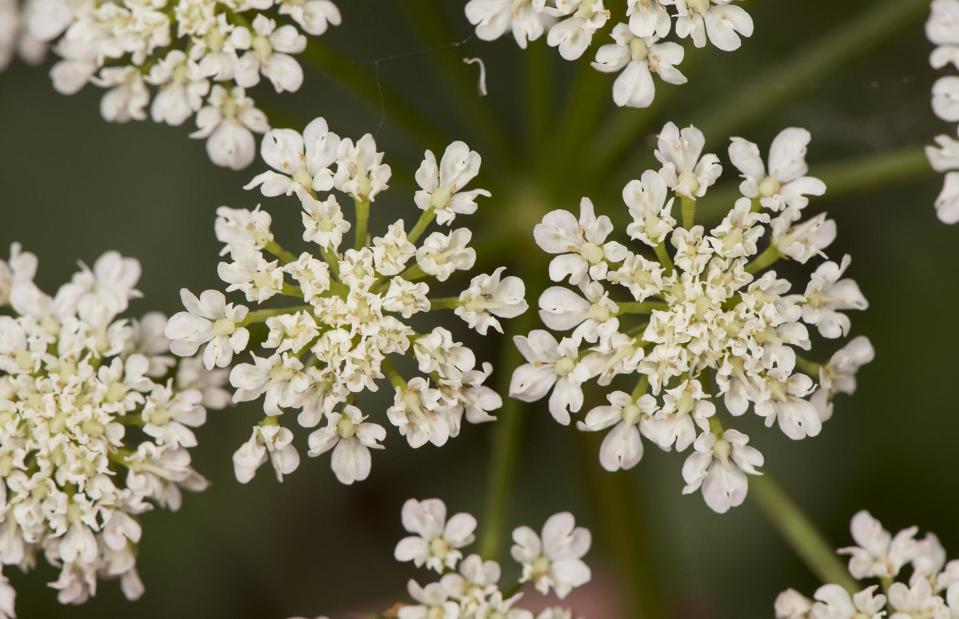
Paco Moreno / Shutterstock
Already have some growing in your garden? Then you'll want to remove it. However, it's best to call in a professional, as this plant spreads easily, with its seeds dispersed by wind, rain or movement.
The best way to remove the plant is by digging up the roots, but failure to extract the entire root can lead to regrow, so call in weed control to ensure a thorough job.
Rhubarb (Rheum rhabarbarum)
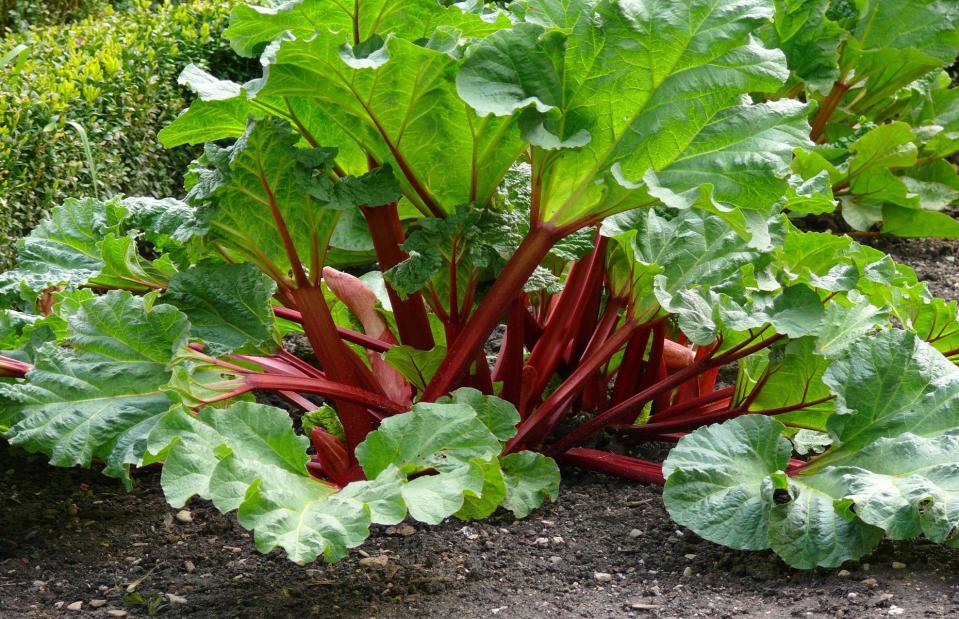
imageBROKER.com / Shutterstock
There's nothing like growing your own fruits and vegetables and rhubarb is a popular option, since it's a hardy plant that can live for numerous years. Plus, it thrives in even the coldest spots of the garden, as well as providing growers with delicious fruit throughout spring and summer.
Requiring lots of space to grow, rhubarb is defined by its bold red stems and large leaves. However 'British' the plant might seem, it's actually native to Siberia and western China. There are a few other downsides to this non-native perennial, too...
What problems can rhubarb cause?
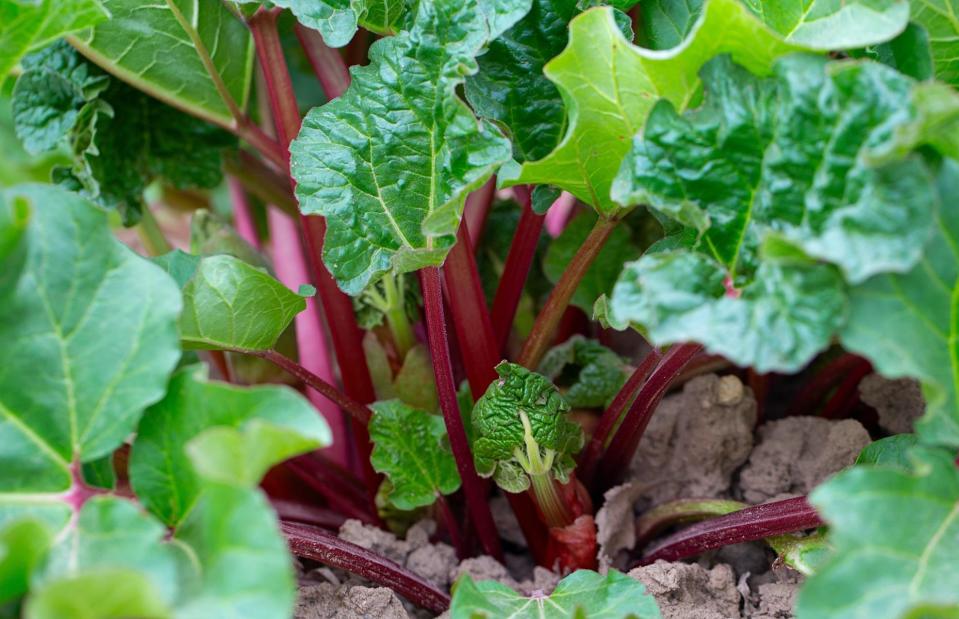
Diana Taliun / Shutterstock
Although delicious when cooked with plenty of sugar, rhubarb actually contains an organic acid known as oxalate. The stalks feature small amounts, making them safe to eat, but the leaves contain much higher traces, rendering them toxic to humans. Therefore, the leaves should never be ingested.
Additionally, in 2023 it was revealed that the UK government will be enacting a ban on giant rhubarb (Gunnera). This variety of the plant is from South America and is said to spread rapidly and choke native plants.
How to stop rhubarb causing harm
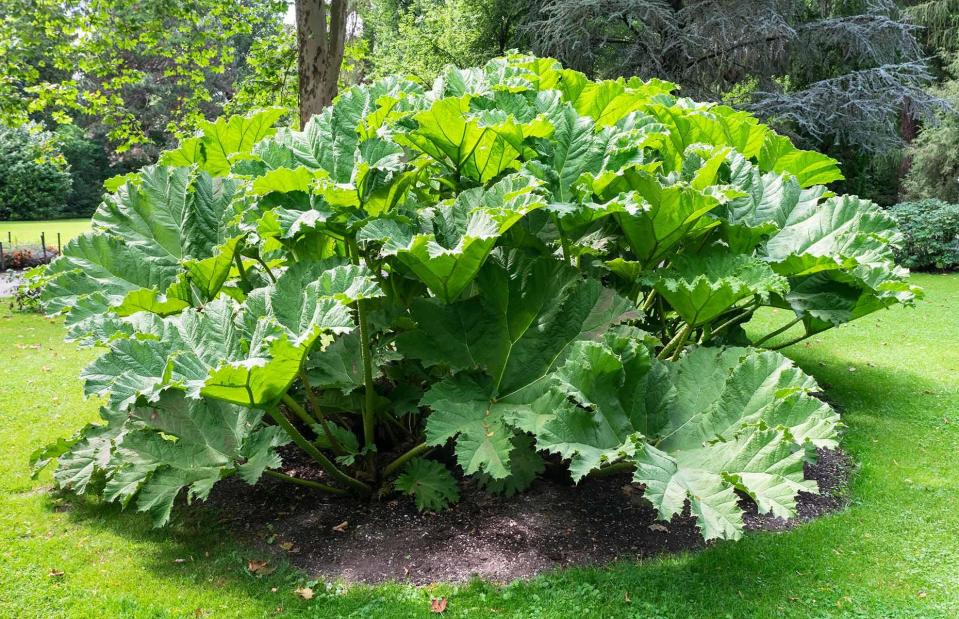
Menno van der Haven / Shutterstock
So, anyone with a regular rhubarb plant can continue to grow it, taking care around the leaves. However, if you have a giant rhubarb plant you will need to call in a professional to safely remove it.
Three-cornered garlic (Allium triquetrum)
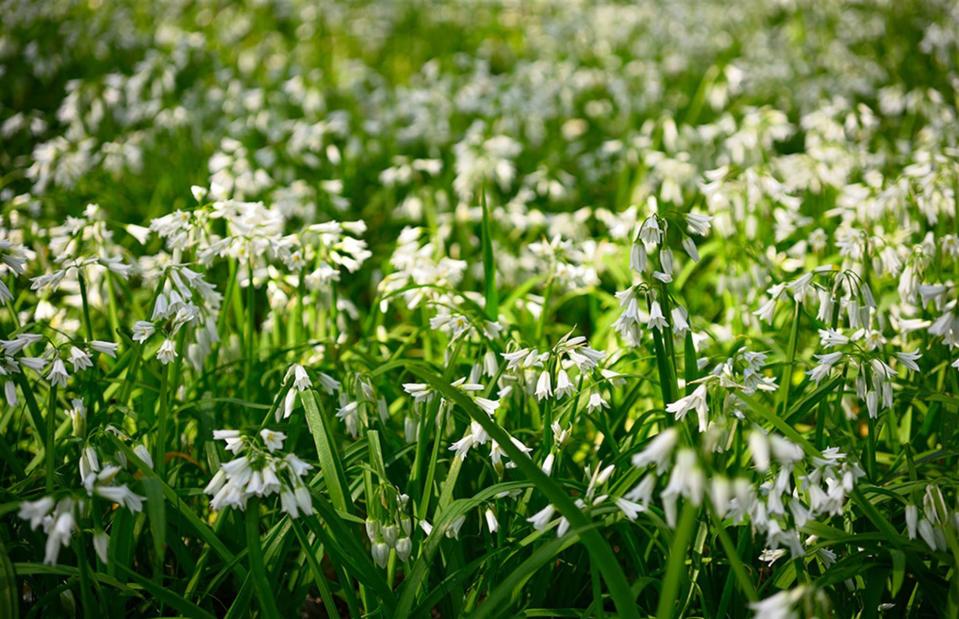
AlessandroZocc / Shutterstock
Also known as angled onion, onion weed or three-cornered leek, this plant is native to regions of the Mediterranean, including Spain, Turkey and Greece. It is therefore considered an invasive plant in the UK and further afield, including Australia and New Zealand. In fact, it is illegal to plant or grow it in Britain.
Three-cornered garlic is easy to identify, thanks to its delicate flowers, which hang in clusters from the tip of green stems. They resemble bluebells but are white with a green stripe along each of its six petals.
What problems can three-cornered garlic cause?
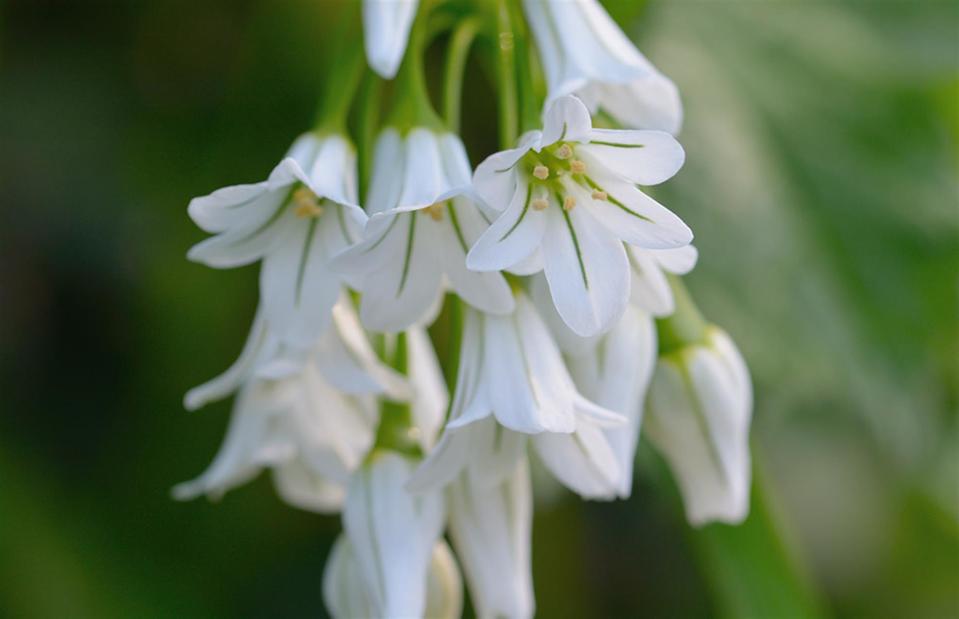
Tom Meaker / Shutterstock
The plant is considered problematic because it can quickly form dense colonies that can overwhelm native plants, such as violets and primroses. It spreads via seeds and bulbils (false seeds produced by a garlic plant in order to reproduce) and even by ants, who carry the seeds to new locations, where it quickly spreads.
How to stop three-cornered garlic causing harm
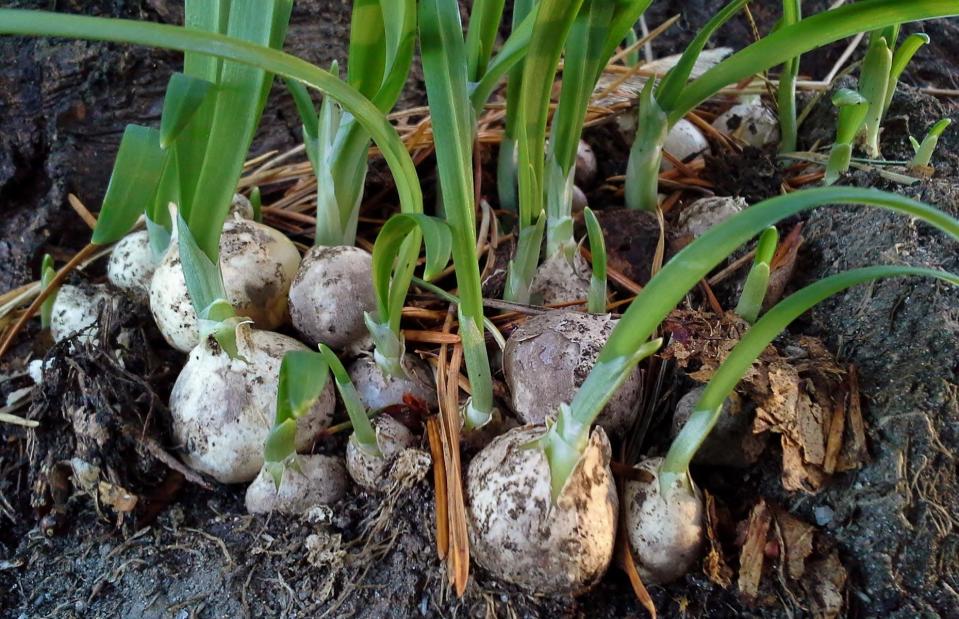
EMFA16 / Shutterstock
As an illegal plant in some parts of the world, it's important to remove it with caution. It is best approached with the use of herbicides or by carefully digging up the plant.
Remove all bulbs using a hand trowel or fork and consider sieving the soil to ensure you’ve removed smaller bulbs.
Butterfly bush (Buddleja)
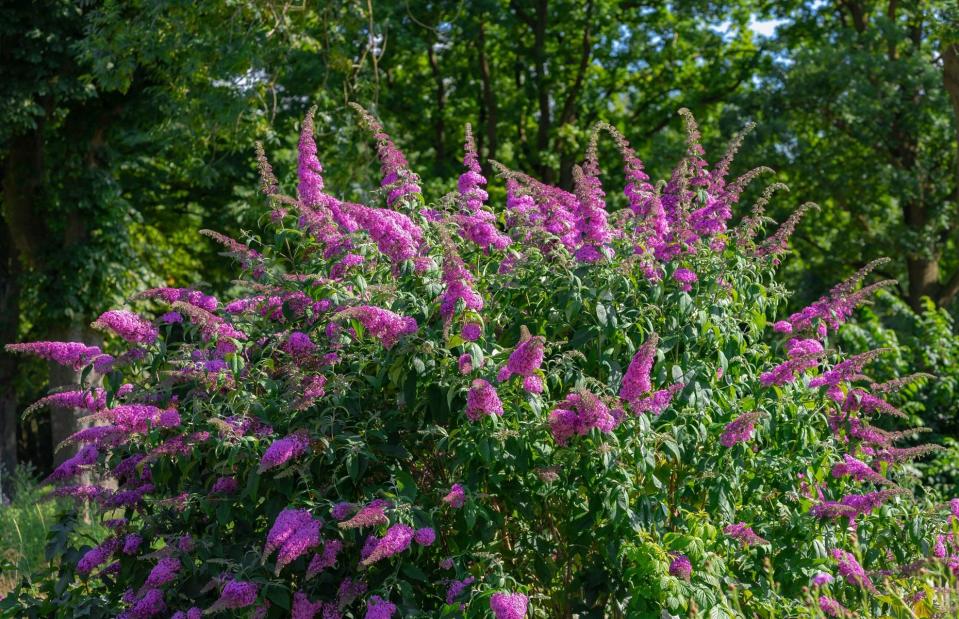
Wut_Moppie / Shutterstock
One look at this stunning plant and it isn't hard to see why people love it. With its vibrant, conical blooms and lovely fragrance, the butterfly bush is a striking addition to any garden. The plant grows easily in a sunny spot and only needs a bit of annual pruning to look good.
Depending on the variety, the plant can produce flowers in a range of shades, from white to pink, lilac and crimson. However, the Buddleja is only native to western China and Brits are now being warned about this invasive species. However, the butterfly bush could be wreaking havoc on your home and garden....
What problems can butterfly bush cause?
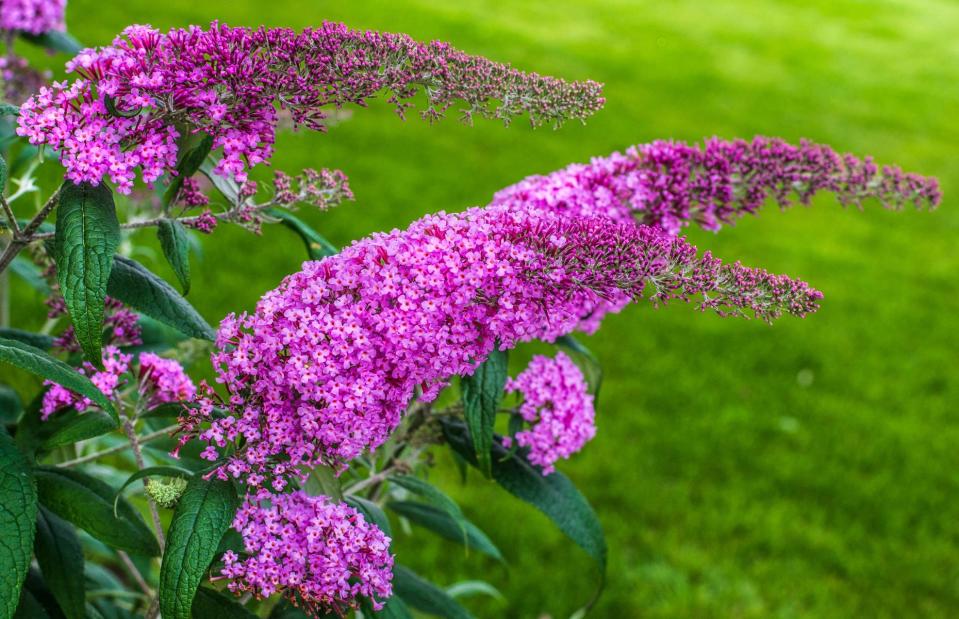
Inoplanium / Shutterstock
According to experts from GardenBuildingsDirect.co.uk, the plant could be even more dangerous than Japanese Knotweed. That's because it spreads by seed and can germinate in unwanted places, such as roofs, walls and window sills.
Its "strong fibrous roots allow the bush to grow through buildings and foundations, giving it the potential to cause costly damage to homes across the UK", they explain. The invasive shrub could therefore negatively impact the value of your home.
Plus, it outcompetes native plants, by spreading roots and taking up space and due to the amount of nectar it produces, the bush distracts pollinators from native co-flowering species.
How to stop butterfly bush causing harm
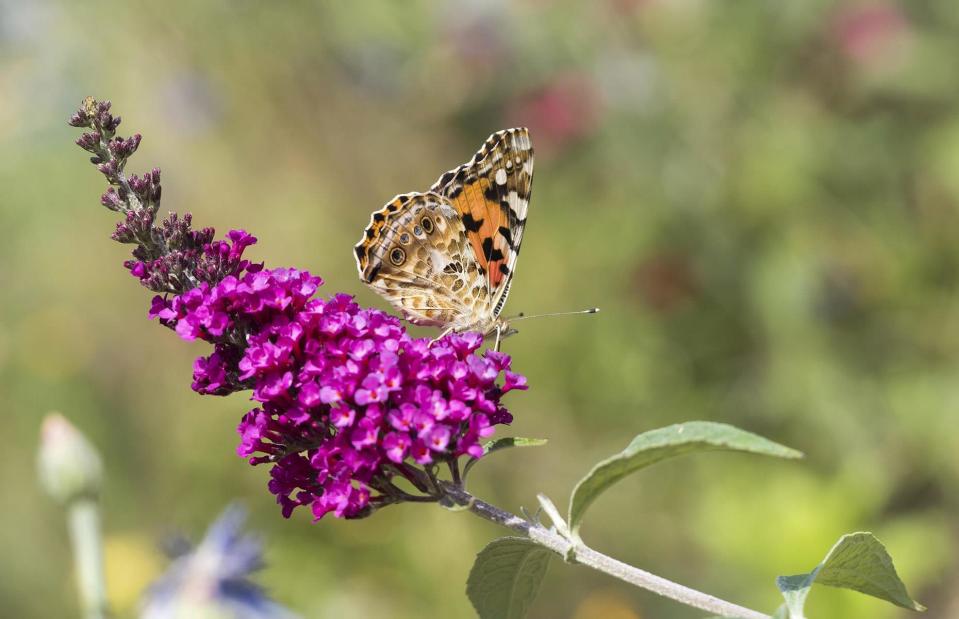
imageBROKER .com / Shutterstock
Therefore, the advice is that anyone with a butterfly bush should remove it by spraying or injecting herbicide into the trunk.
If the plant has already infiltrated your home’s structure, then it must be extracted by professionals to prevent further damage.
Himalayan balsam (Impatiens glandulifera)
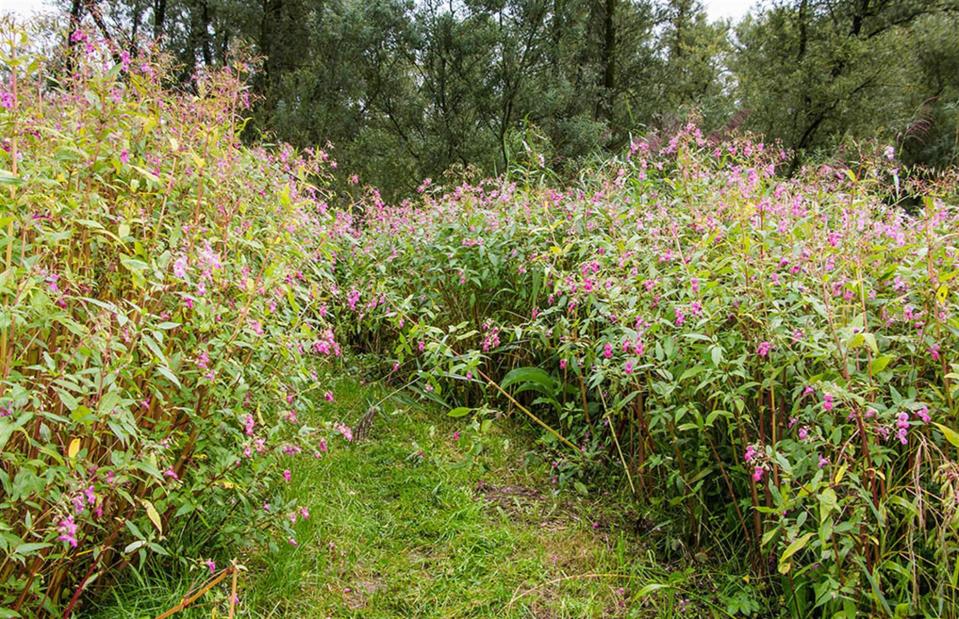
INTREEGUE Photography / Shutterstock
As its name suggests, the Himalayan balsam is native to the Himalayas. Because of this, it is considered an invasive plant in the UK, as well as Canada and the United States. Related to the Busy Lizzie, the riparian plant species grows tall and between June and October is identifiable by its pretty pink or purple flowers, which are helmet shaped.
It has long, pointy leaves, serrated at the edges and after flowering, seed pods appear, which explode open. Sadly, the weed is now naturalised in the UK and North America, meaning it has adapted to these environments and now thrives. As such, it is an offence to grow it in the wild in Britain.
What problems can Himalayan balsam cause?
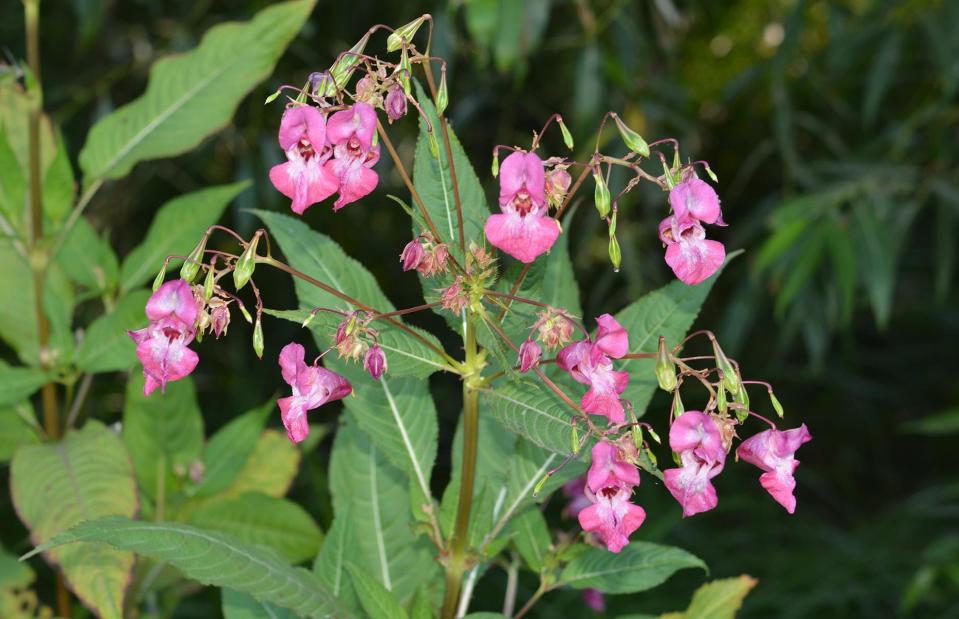
weha / Shutterstock
Although some gardeners like Himalayan balsam because of the quality of bee-attracting nectar it produces, this plant is largely considered a nuisance and a weed.
It grows rapidly and shades out other vegetation, gradually destroying habitats and killing off important native plants.
How to stop Himalayan balsam causing harm
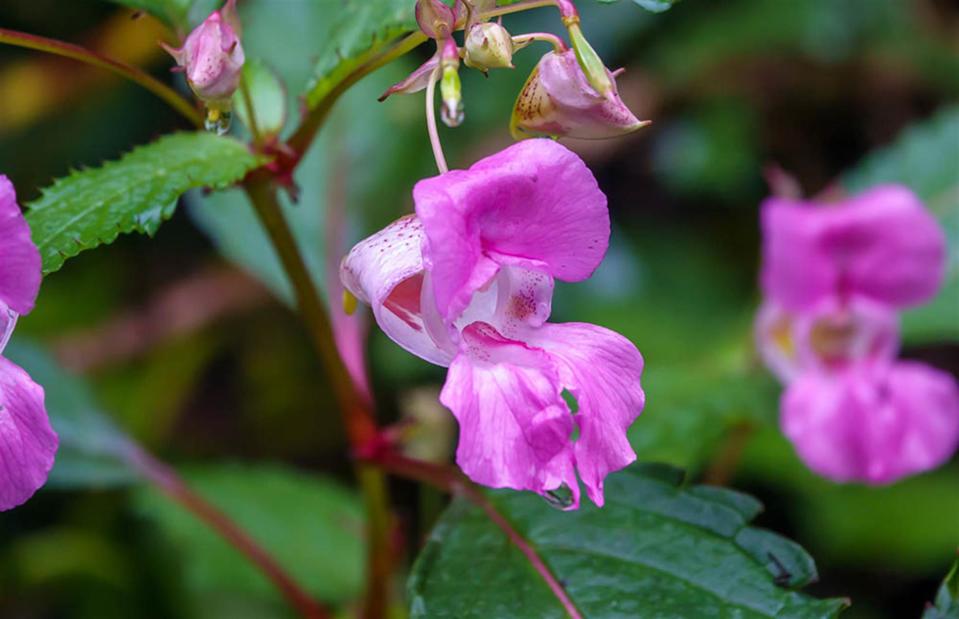
Martin Hibberd / Shutterstock
To remove it, you can try cutting the plant back – ideally before it flowers or seeds each year.
For problematic areas, dig out the plant or use a glyphosate-based weedkiller, applied directly to the foliage. Used carefully, it shouldn’t damage nearby plants.
Japanese knotweed (Reynoutria japonica)
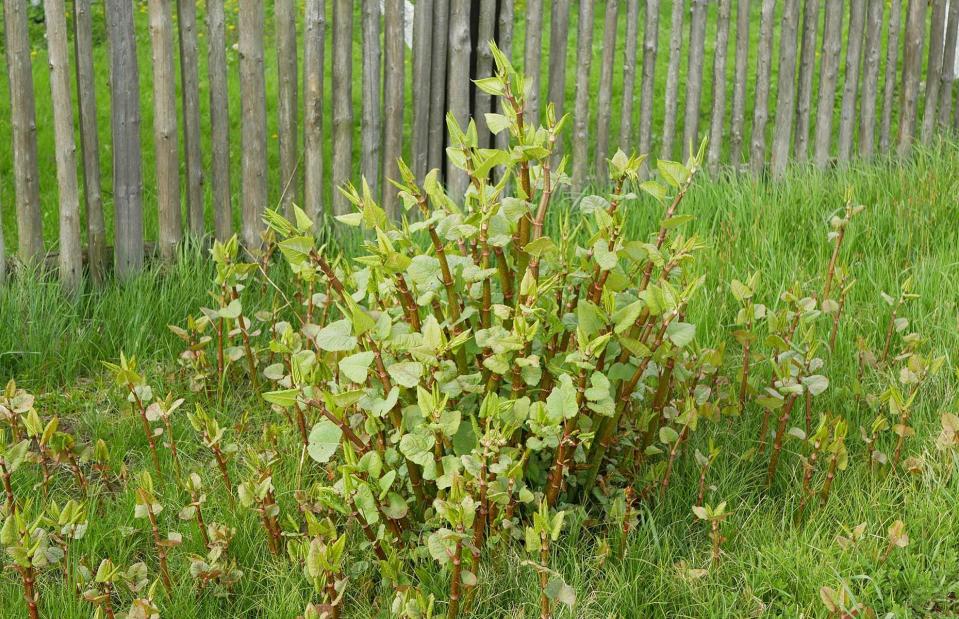
Tomas Vynikal / Shutterstock
Japanese knotweed is perhaps one of the most well-known and feared invasive plants in the world. Native to Japan, China, parts of Korea and Taiwan, this perennial weed features heart or shovel-shaped leaves.
From late spring, reddish-purple shoots, emerging from pink buds, may be seen at ground level, while in summer they usually look more like tall canes with purple flowers. In late summer and autumn, white flowers will appear.
What problems can Japanese knotweed cause?
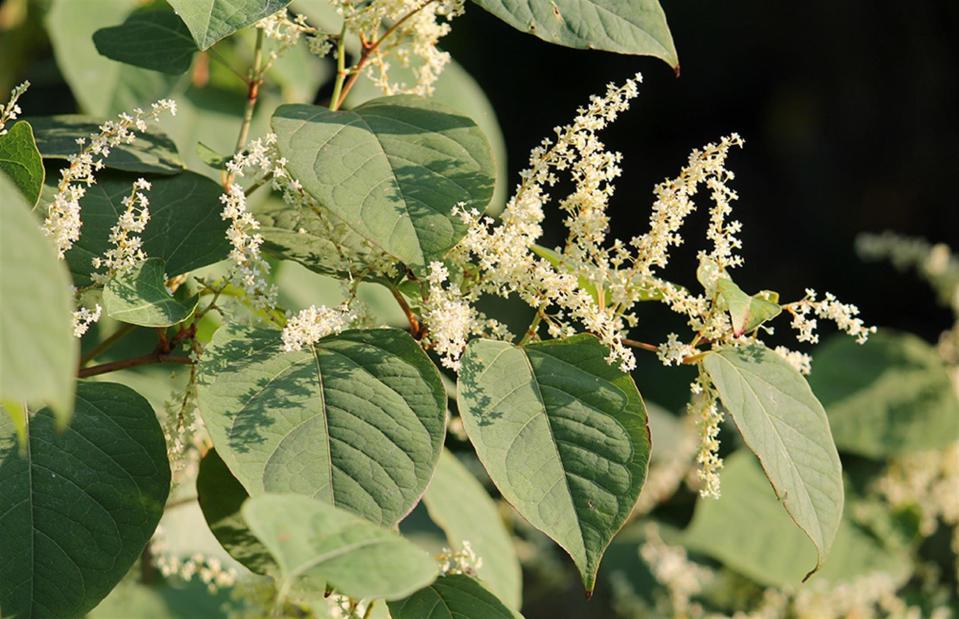
2018 Kazakov Maksim / Shutterstock
Incredibly hardy and easily pleased, this weed spreads rapidly and will also grow through cracks in walls or through pipes, leading to structural damage.
If you identify Japanese knotweed on your property, then you should act quickly to prevent it from spreading further.
How to stop Japanese knotweed causing harm

Leon Brouwer / Shutterstock
Japanese knotweed can grow between 10 and 13 feet (3-4m) in just 10 weeks and effective treatment can take up to five years.
You can manage small patches on your own, but as it is considered controlled waste, it must be disposed of properly, at a licensed landfill site. To avoid repeat issues, it's advisable to hire an accredited knotweed removal firm.
Ivy (Hedera)
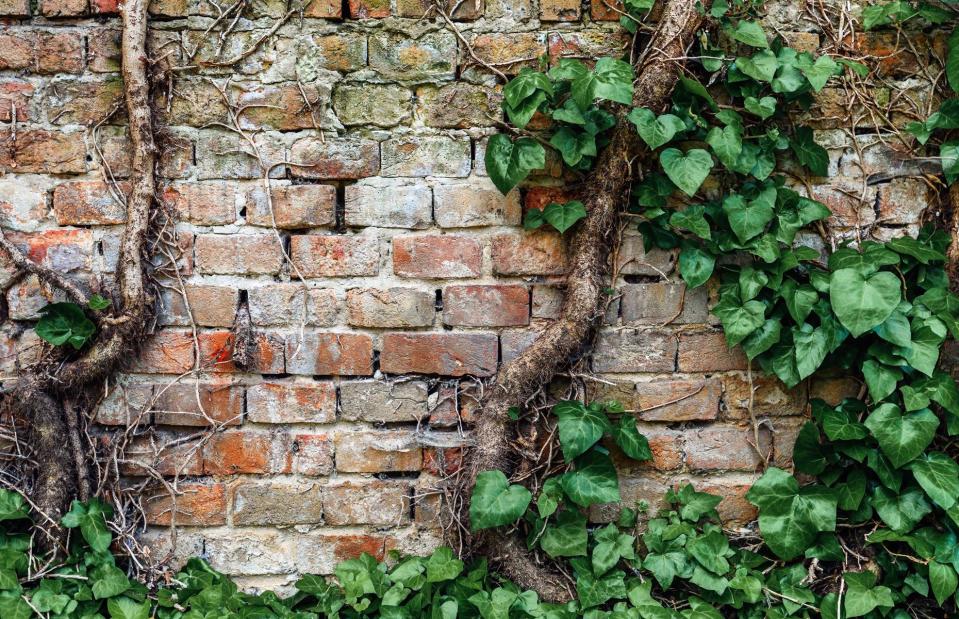
Bits And Splits / Shutterstock
There's no denying that ivy can look really beautiful, climbing up the front of doorways and trellises. With its glossy and evergreen five-lobed leaves, this climber plant is native to most of Europe and parts of western Asia.
It's fantastic for attracting wildlife and keeping buildings cool in summer, too, so it's no wonder it's been a popular choice for gardeners for centuries. However, there are a few things to bear in mind if you have ivy growing in your garden.
What problems can ivy cause?
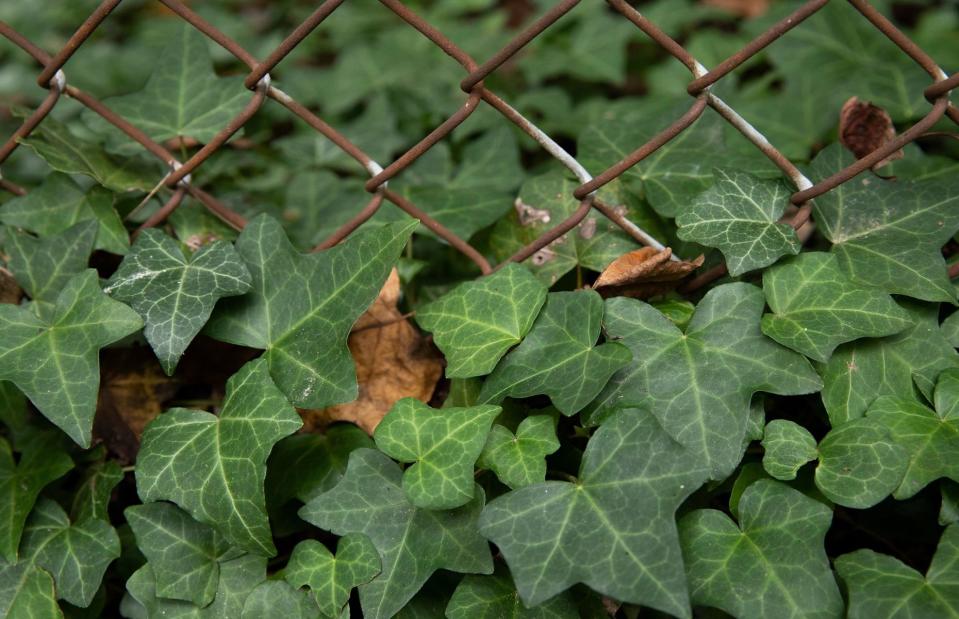
Tiffany C Ward / Shutterstock
Since ivy likes to climb, it can soon infiltrate cracks and cause structural damage. Plus, the plant is mildly poisonous and if eaten will cause an upset stomach.
Ivy is also toxic to cats, dogs and horses and children under five are most at risk from ivy poisoning.
How to stop ivy causing harm

Ronin of Rock / Shutterstock
So, if you have ivy growing you'll need to prune it regularly, ensuring no nesting birds are hiding in the foliage.
If you want to remove the plant, cut the stems back to the ground and dig out the wooden stump. Aerial roots are stubborn and may need to be removed using a hard brush or some kind of scraper.
Lily of the valley (Convallaria majalis)
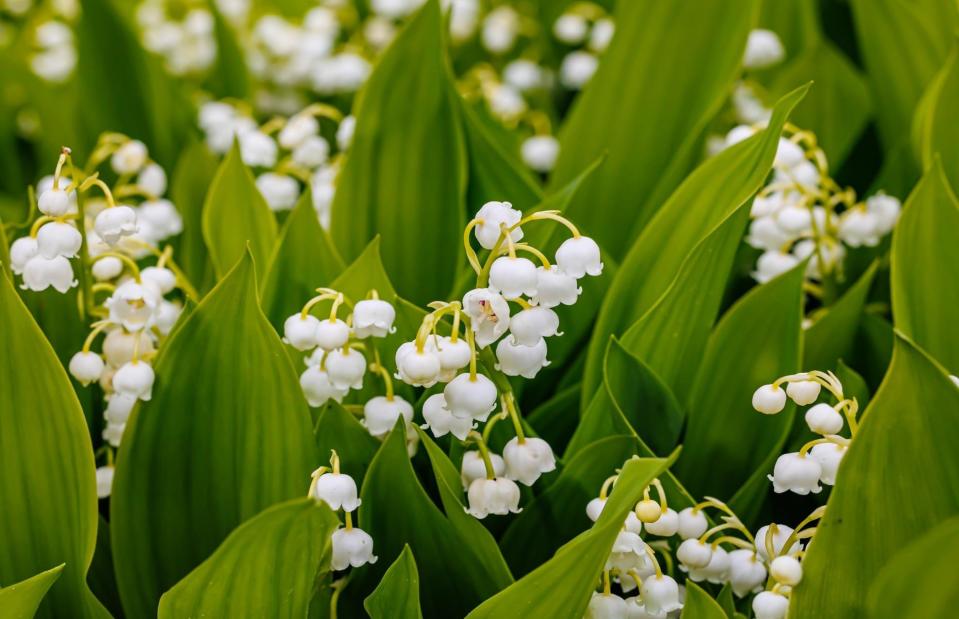
nnattalli / Shutterstock
A true icon of the plant world, lily of the valley not only showcases delicate white flowers, but is easy to grow and maintain, and provides a wonderful scent, too. This is why, for centuries, gardeners have been choosing it for their flower beds.
The plant can be identified by its tall, green leaves and its pretty, bell-shaped flowers. They love moisture and thrive in shaded beds, which is why they often flourish beneath trees.
Sound too good to be true? There are a few issues when it comes to this gorgeous native European and Asian plant...
What problems can lily of the valley cause?
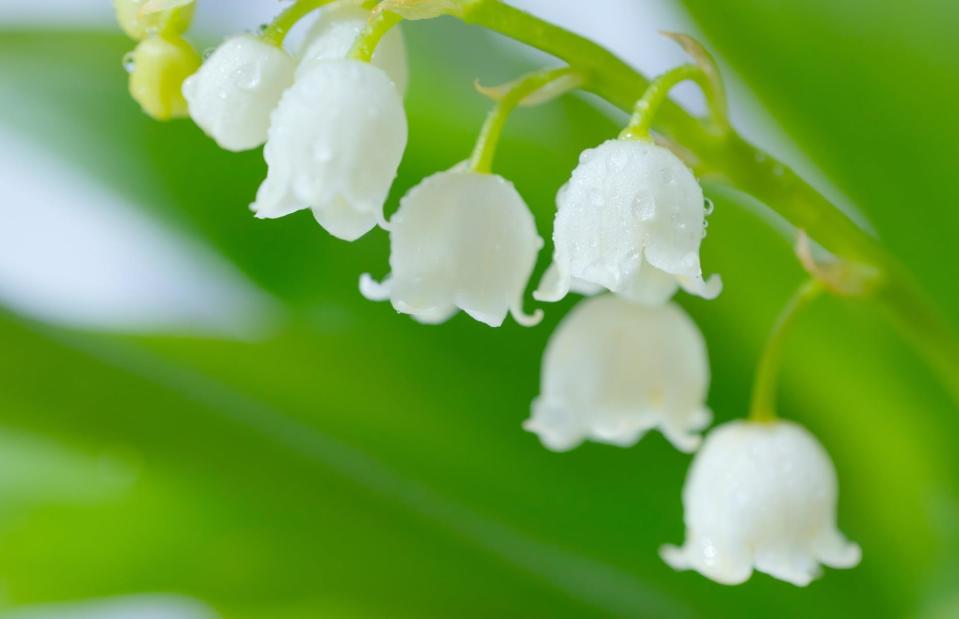
kholywood / Shutterstock
Sadly, this pretty plant is toxic when ingested and its cardiac glycosides have a similar effect to that of Digitalis (foxgloves).
Another issue to consider is that common garden pests, like aphids and spider mites, love lily of the valley. However, most infestations can be easily treated.
How to stop lily of the valley causing harm
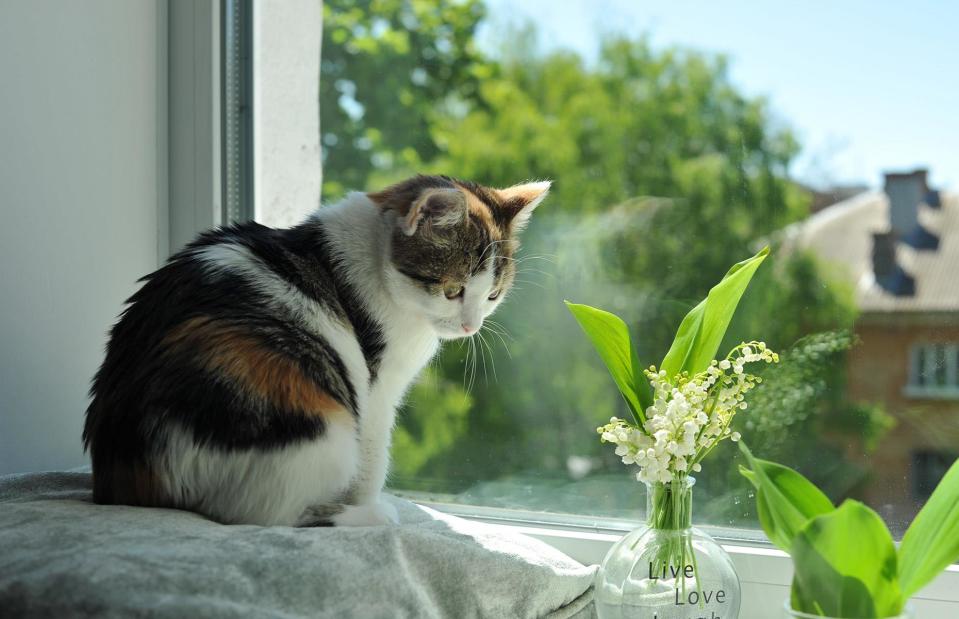
Natali9701 / Shutterstock
It's ok to grow this plant in your garden, but just ensure you use special caution and consider planting it out of reach of children and pets.
New Zealand pygmyweed (Crassula helmsii)

Roa-Z3 / Shutterstock
Sometimes called Australian swamp stonecrop, New Zealand pygmyweed is a succulent that grows in bodies of water, such as ponds, lakes and canals. The aquatic plant features yellowish-green, fleshy leaves – akin to other succulents – and solitary white or pale pink flowers.
As the name suggests, this plant isn't native to Europe and was introduced to Britain from Tasmania in 1911. As such, it has become a bit of a problem for nature spots across the UK.
What problems can New Zealand pygmyweed cause?
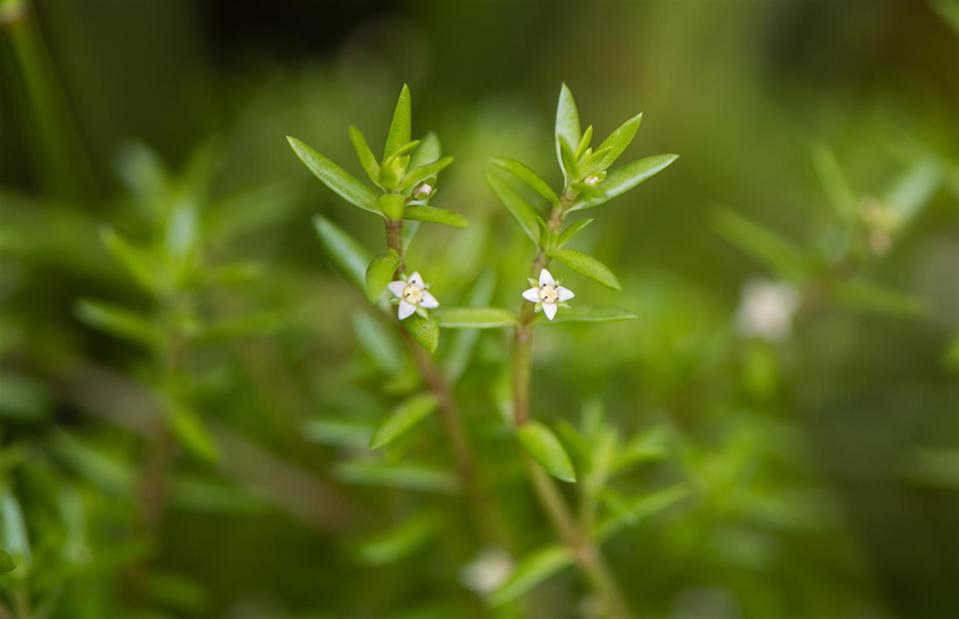
IanRedding / Shutterstock
Due to its large mats of branches, New Zealand pygmyweed shades out other plants and reduces the oxygen in the water below, which can be very harmful to pond life, including fish, frogs and newts.
Because of this, it is now one of five water plants that are illegal to sell in the UK, but if you have a body of water in your garden then there's a chance this plant is thriving there.
How to stop New Zealand pygmyweed causing harm
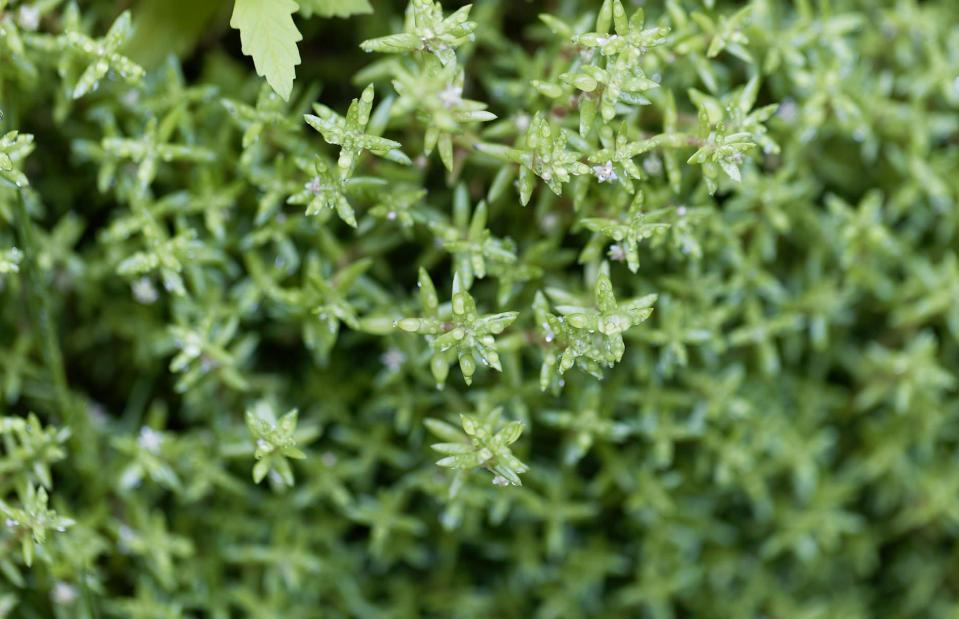
ChWeiss / Shutterstock
You can kill the plant using glyphosate-based herbicides, applied to the leaves themselves. However, you might want to drain the pond or lake first, to ensure you're reaching any plants hidden below the surface of the water.
Worth noting is that the plant can travel from one body of water to another on clothes and equipment, so be sure to clean everything once you’ve tackled it.
Giant hogweed (Heracleum mantegazzianum)
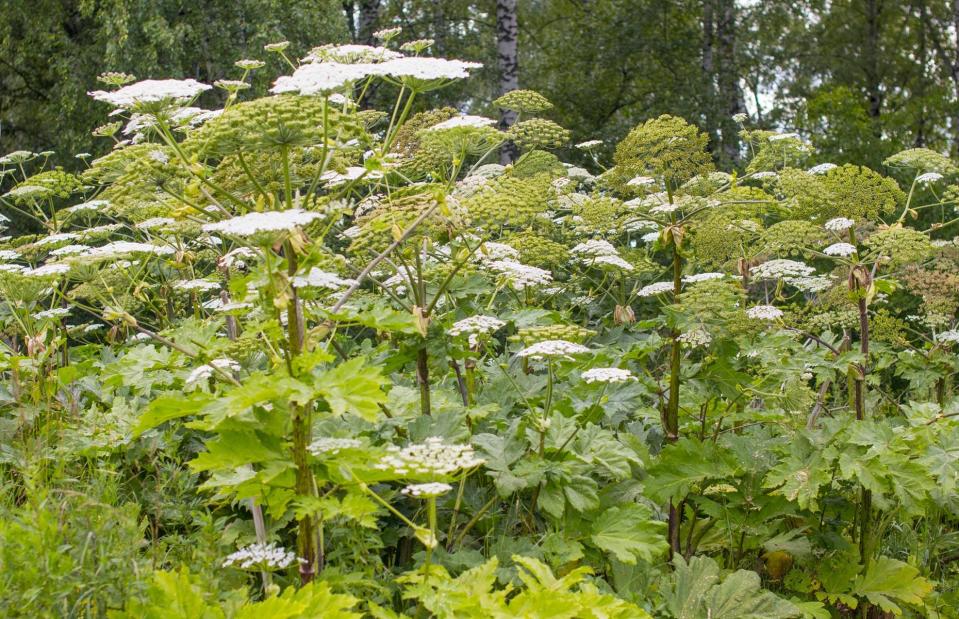
svetlana-81 / Shutterstock
Giant hogweed is part of the cow parsley family and features long, flowering stems that typically reach between 6.5 feet (1.9m) and 10 feet (3m) high. It has umbrella-like flower heads and large, jagged leaves.
It can often be spotted near streams and rivers, since it prefers moist soil and partial shade. The very definition of a weed, giant hogweed originates from the Caucasus Mountains, so is invasive within the UK and several other countries. In fact, in Britain, it is illegal to plant giant hogweed or allow it to grow.
What problems can giant hogweed cause?
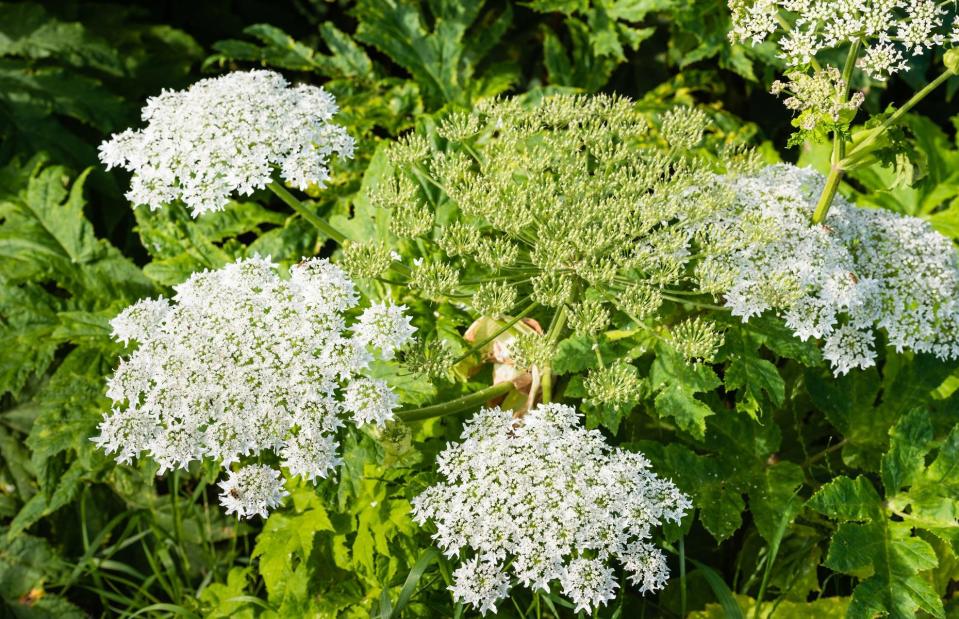
Ruud Morijn Photographer / Shutterstock
The issue is that giant hogweed is hazardous. Its sap contains toxic chemicals that can sensitise human skin to ultraviolet light, causing it to blister within days. Scarily, the effects can last for years.
How to stop giant hogweed causing harm
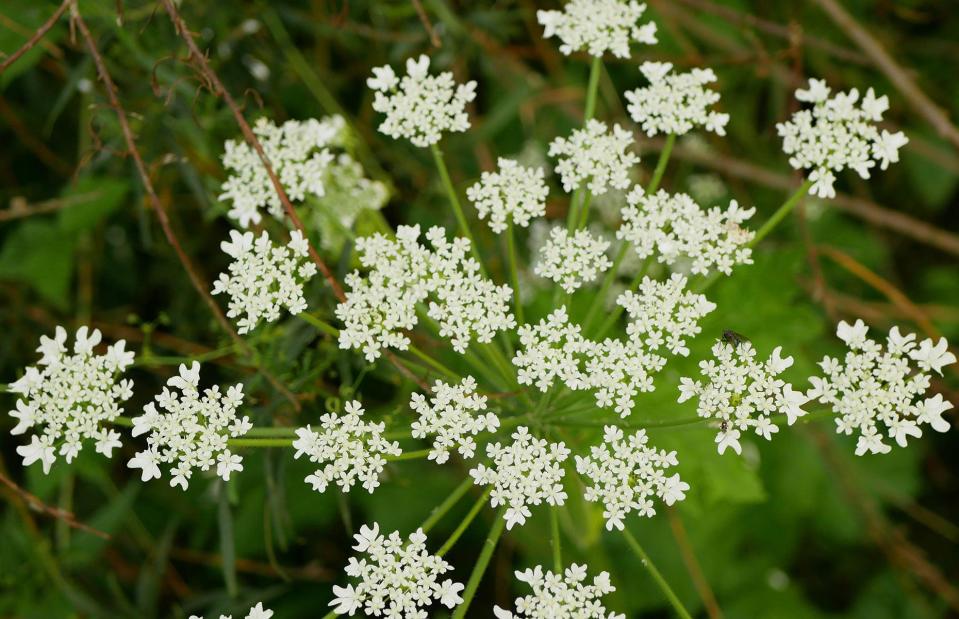
Tomas Vynikal / Shutterstock
If the plant is found within the boundary of your property you must take precautions to stop it from spreading. Even better, irradicate it completely.
Start by covering yourself well with long sleeves, trousers and gloves. Ideally, you'll want a face mask, too. May is said to be the best time to attempt to pull young plants up by hand and you should never let hogweed set seed, as this is how the plant reproduces. So, aim to remove the plant before its flowers start to wither.
Daffodil (Narcissus pseudonarcissus)
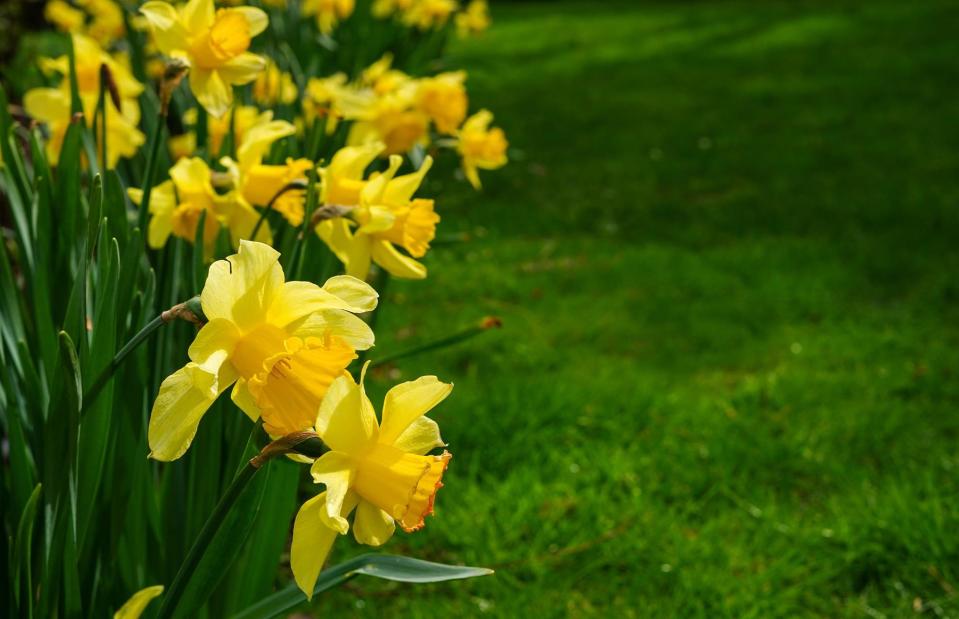
nastya_ph / Shutterstock
We know what you're thinking – how can one of the world's best-loved flowers be dangerous? Well, we'll get to that shortly. But firstly, the daffodil epitomises spring and is the national flower of Wales.
Originally from Europe and Northern Africa, this lovely bloom boasts a long, green stem with equally long leaves and a single yellow or white trumpet-shaped flower at the end. So, what's the problem?
What problems can daffodils cause?
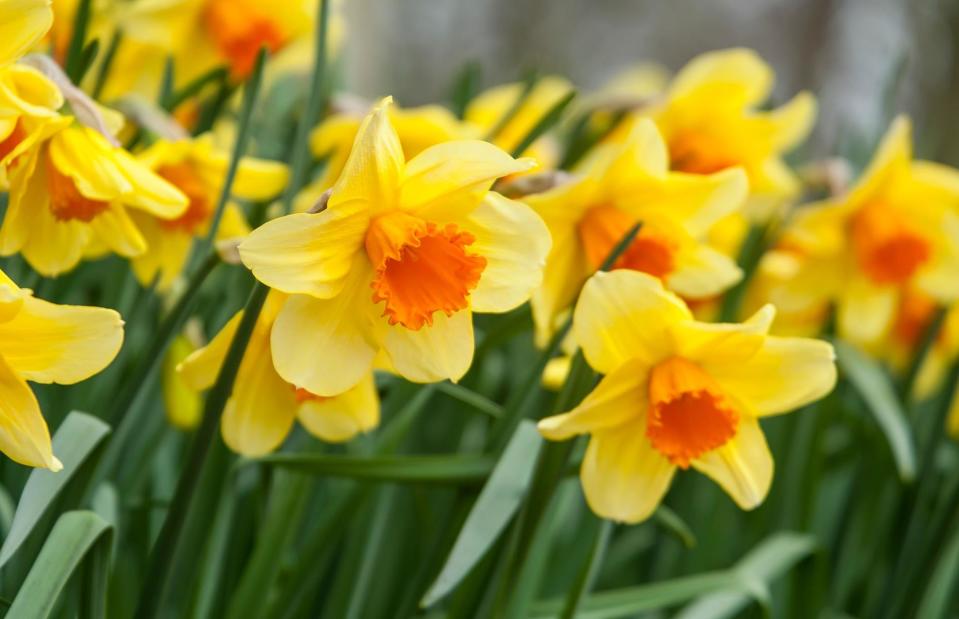
Kurt Vansteelant / Shutterstock
Well, unfortunately, daffodils are poisonous to dogs. The plant, including its bulb, contains a toxin called lycorine, which can cause digestive problems when consumed, leading to vomiting, diarrhoea and convulsions.
"There are other substances in a daffodil flower that might also cause irritation to the skin and to the mouth and throat if ingested," Purina explains.
How to stop daffodils causing harm
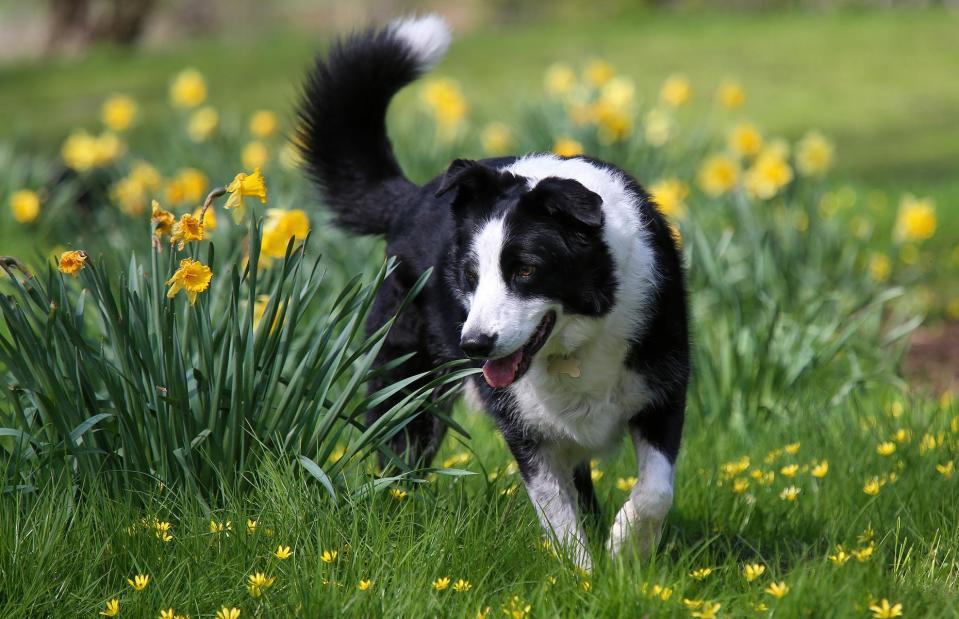
Sue Thatcher / Shutterstock
The best thing is for your dog to avoid close contact with this flower. If you have daffodils in your garden and also own a dog, it might be best to dig them up.
If your dog ingests any part of the daffodil, then Purina recommends removing any flowers from its mouth and calling the vet immediately.


